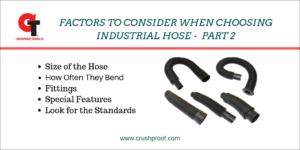Factors to Consider when Choosing Industrial Hose – Part 2
There are myriad applications for rubber hoses when it comes to fluid, gas, or material transfer across industries. Made to meet your custom specifications, they can be found in the automotive, construction, food, medical, chemical, petroleum, and agricultural industries, just to name a few. Each of these industries has diverse requirements, and hence ‘one size fits all’ doesn’t ring true.

To meet these diverse requirements, hose manufacturers are creating innovative types of custom hose, which in turn makes the selection process a difficult task. In the last post, we had listed a few factors to consider while selecting industrial hoses for your application. This post lists the rest of the significant factors to consider:
- Size of the Hose: This sounds simple enough, but beyond the inside diameter, it’s also important to consider the wall thickness, outside diameter, and minimum and maximum length if elongation is relevant.
- How Often They Bend: This is probably the feature that gets most overlooked. Just because a hose is “flexible,” doesn’t mean it is meant to flex all the time or that it actually has a tight bend radius. Wall thickness, base material, reinforcement material (if any), and layer count combine to determine the bend radius of a hose and how many bend cycles they can survive before failure. Temperature can play a key role here as well. A hose that can handle regular bend cycling at 50°F may fail quickly at -50°F even though the hose may have a temperature rating of -50°F. That is possible because a hose could be fine being exposed to cold temperatures and working fine once it returns to warmer temperatures, but it can’t really flex like it should when cold. Bending through hot and cold cycling can also cause problems with delamination where different materials are used to make a hose.
- Fittings: Similar to the considerations you make when purchasing hose, it is equally important to source the right fittings like clamps and connectors. Consider the corrosiveness of the application area, working pressure, how secure fittings need to be, whether they should be removable or not, and if they need to be airtight or watertight before choosing the fittings for your industrial hoses.
- Special Features: Sometimes a special feature like stretchability, flame retardance, or gas permeation resistance are going to drive the application requirements. It can help to find the special requirement first to narrow your search because these situations can often mean other desired features will have to take a back seat to the core requirement. It then becomes important to prioritize what is most critical because not every application has a hose that can check off all the boxes.
- Look for the Standards: Hoses are available in compliance to a wide range of standards. A few amongst the popular standards exist include:
- SAE
- ASTM
- MIL-SPEC
- ISO
- CE
With the discussion in these posts, we hope we’ve shed some light on the importance of considering all the factors during the selection of industrial hoses. Spending time assessing these factors beforehand can save you and your equipment a lot of time and money in the long run. Purchasing these industrial hose from leading manufacturers like Crushproof Tubing also helps in getting the right hose for your applications. The team of experts at the company offer expert technical guidance throughout the selection process.
Related Post
- Why Custom Rubber Tubing is a Great Choice for Medical Device Manufacturers
- An Overview of Five Popular Industrial Hoses and Their Applications
- Six Benefits of Choosing EPDM Drain Hoses for Your Facility
- Improve Your Supply Chain with Domestic Hose Solutions
- Know the Difference Between Durable Vs. Disposable Medical Tubing
- An Ultimate Guide: Choose the Right Flexible Rubber Bellows for Pumps
- Top 5 Things to Consider When Choosing Medical Hoses and Tubing
- An Overview of the Types, Benefits and Applications of Flexible Plastic Tubing and Hose
- How to Build Custom Hoses at Crushproof Tubing Company
- Factors to Consider when Choosing Industrial Hose – Part 1

